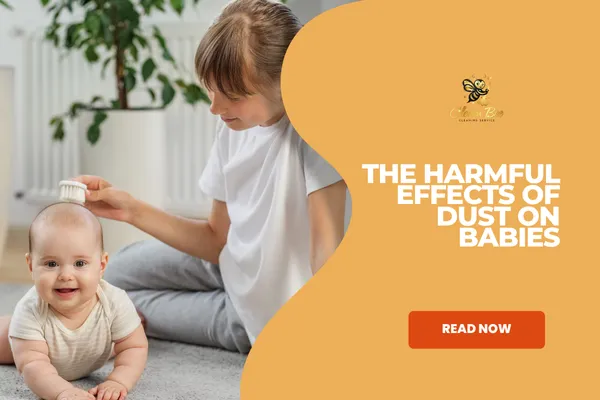
The Harmful Effects of Dust on Babies
Every parent wants their baby to grow up healthy and happy, but many don’t realize that something as simple as dust can pose real risks to a child’s well-being. Babies spend most of their time close to the floor — crawling, playing, and exploring — which means they’re more exposed to dust than adults. Keeping your home clean isn’t just about appearances; it’s about creating a safe, breathable, and healthy environment for your little one.
Why Dust Is More Dangerous for Babies
Babies have developing immune systems and smaller airways, making them more sensitive to airborne particles. When dust builds up, it often carries microscopic allergens, mold spores, pet dander, and even harmful chemicals that can easily irritate their lungs or skin.
Even a small amount of dust in carpets, curtains, or bedding can trigger sneezing, coughing, watery eyes, or skin irritation. Over time, frequent exposure may increase the risk of asthma, allergies, or respiratory infections in infants and toddlers.
Common Places Where Dust Hides
You might be surprised by how quickly dust collects in your home. Here are a few common spots where it tends to settle:
Carpets and rugs – trap dust and allergens deep in the fibers.
Curtains and blinds – collect fine particles from open windows.
Under furniture and cribs – areas often missed during quick cleans.
Stuffed toys and bedding – hold dust mites and bacteria.
Ceiling fans, vents, and baseboards – circulate dust each time they’re used.
How Dust Affects a Baby’s Health
Respiratory Issues
Dust particles can enter the lungs and cause inflammation. In babies, this may appear as wheezing, coughing, or labored breathing.Allergic Reactions
Dust mites and allergens can cause skin rashes, itching, or runny noses, especially in sensitive babies.Sleep Disturbances
Dusty air can irritate nasal passages, making it harder for babies to breathe comfortably while sleeping.Weakened Immune System
Prolonged exposure to poor air quality may put stress on a baby’s still-developing immune system, leading to more frequent colds or infections.
How to Keep Your Home Safe and Dust-Free
1. Vacuum Regularly with a HEPA Filter
A HEPA vacuum traps tiny particles that regular vacuums may recirculate into the air. Focus on carpets, rugs, and corners where dust tends to collect.
2. Wash Bedding and Stuffed Toys Weekly
Use warm water to eliminate dust mites and bacteria. For non-washable items, place them in the dryer on high heat for a few minutes to help remove dust.
3. Dust Surfaces with a Damp Cloth
Dry dusting can push particles into the air. Instead, use a slightly damp microfiber cloth to trap dust effectively.
4. Change Air Filters Often
Check HVAC and air purifier filters regularly. Clean or replace them as needed to keep your home’s air fresh and healthy.
5. Avoid Clutter Around the Crib
Decorations, stuffed animals, and piles of clothes can trap dust and make cleaning harder. Keep baby spaces light and minimal.
6. Schedule Professional Cleaning
Even with regular upkeep, dust hides in places that are easy to miss. A professional cleaning service can deep clean every area — from vents to baseboards — ensuring your baby’s environment is spotless and safe.
Creating a Healthier Home for Your Little One
A clean home means more than just a sparkling space — it means your baby can breathe better, sleep soundly, and grow in a safe environment. Dust may seem small, but its effects on a baby’s health can be significant.
At Gleam Bee Cleaning Service, we understand how important a healthy home is for growing families. Our team uses safe, effective cleaning methods that reduce dust and allergens without harsh chemicals, helping you create the clean, comfortable space your baby deserves.